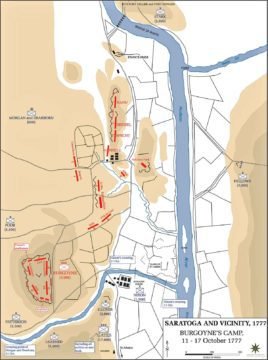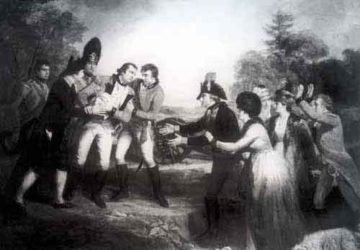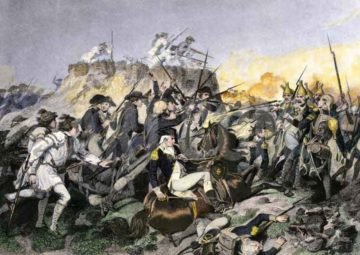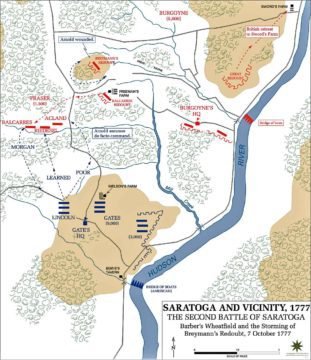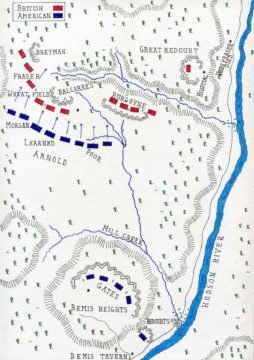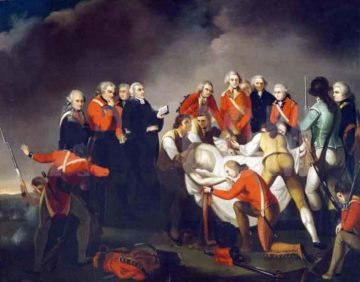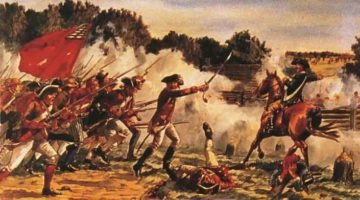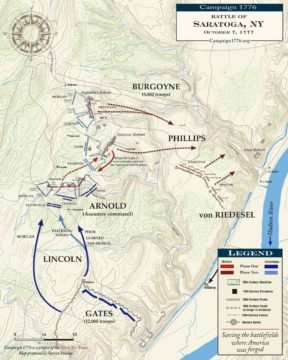The Saratoga (Second)/Bemis Height’s
October 7, 1777 in Saratoga, New York

Battle Summary
The Battles of Saratoga (Freeman’s Farm and Bemis Heights) marked the climax of the Saratoga Campaign, giving a decisive victory to the Americans over the British in the Revolutionary War. Lieutenant General John Burgoyne led a large invasion army southward from Canada in the Champlain Valley, hoping to meet a similar British force marching northward from New York City and another British force marching eastward from Lake Ontario.
The southern and western forces never arrived, and Burgoyne was surrounded by American forces in upstate New York. He fought two small battles to break out which took place 18 days apart on the same ground, 9 miles south of Saratoga, New York. They both failed.
Burgoyne found himself trapped by superior American forces with no relief in sight, so he retreated to Saratoga (now Schuylerville) and surrendered his entire army there on October 17. His surrender, says historian Edmund Morgan, “was a great turning point of the war because it won for Americans the foreign assistance which was the last element needed for victory.”
Burgoyne’s strategy to divide New England from the southern colonies had started well but slowed due to logistical problems. He won a small tactical victory over Major General Horatio Gates and the Continental Army in the September 19 Battle of Freeman’s Farm at the cost of significant casualties. His gains were erased when he again attacked the Americans in the Battle of Bemis Heights and the Americans captured a portion of the British defenses.
Burgoyne was therefore compelled to retreat, and his army was surrounded by the much larger American force at Saratoga, forcing him to surrender. News of Burgoyne’s surrender was instrumental in formally bringing France into the war as an American ally, although it had previously given supplies, ammunition, and guns, notably the de Valliere cannon which played an important role in Saratoga. This battle also resulted in Spain joining France in the war against Britain.
The battle on September 19 began when Burgoyne moved some of his troops in an attempt to flank the entrenched American position on Bemis Heights. Major General Benedict Arnold anticipated the maneuver and placed significant forces in his way. Burgoyne did gain control of Freeman’s Farm, but it came at the cost of significant casualties.
Skirmishing continued in the days following the battle, while Burgoyne waited in the hope that reinforcements would arrive from New York City. Patriot militia forces continued to arrive, meanwhile, swelling the size of the American army. Disputes within the American camp led Gates to strip Arnold of his command.
General Henry Clinton moved up from New York City and attempted to divert American attention by capturing two forts in the Hudson River highlands on October 6, but his efforts were too late to help Burgoyne. Burgoyne attacked Bemis Heights again on October 7 after it became apparent that he would not receive relieving aid in time.
This battle culminated in heavy fighting marked by Arnold’s spirited rallying of the American troops. Burgoyne’s forces were thrown back to the positions that they held before the September 19 battle and the Americans captured a portion of the entrenched British defenses.
Facts about the Battle of Saratoga (Second)/Bemis Height’s
- Armies – American Forces was commanded by Maj. Gen. Horatio Gates and consisted of about 15,000 Soldiers. British Forces was commanded by Maj. Gen. John Burgoyne and consisted of about 4,000 Soldiers.
- Casualties – American casualties were estimated to be 90 killed and 240 wounded. British casualties were estimated to be 440 killed, 700 wounded, and 6,222 captured.
- Outcome – The result of the battle was an American victory. The battle was part of the Saratoga Campaign 1777.
Prelude
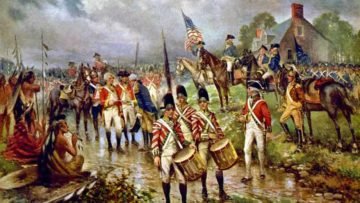
Surrender of General Burgoyne and the British Army to General Gates at the Second Battle of Saratoga
After the Battle of Saratoga (First)/ Freeman’s Farm, Burgoyne strengthened his defensive lines in positions extending from Freeman’s Farm in the west to the Hudson River in the east. To his south, the American force, commanded by Gates, were at the fortifications atop Bemis Heights.
Gates used this same time to strengthen his defensive lines against an anticipated British attack. Also, additional reinforcements were arriving during this same time.
Gates kept his force inside their entrenchments along the high ground just west of the Hudson River. About 3,000 troops and most of his artillery occupied positions overlooking the river. On the north-northwestern position of the line was Brigadier General Benjamin Lincoln‘s 3,800-man division. Lincoln had another 1,200 New York militia, commanded by Brigadier General Abraham T. Broeck, behind him available for immediate support. This area was built around the critical piece of terrain known as Nielson’s farm. If the British captured this area, their artillery could force the Americans to flee Bemis Heights. On the American left (west) were 600 light infantrymen, commanded by Cols. Daniel Morgan and Henry Dearborn.
Burgoyne received word that the Americans had captured one of his supply flotillas on Lake George. He was tempted to abandon the whole enterprise and withdraw to Fort Ticonderoga, but information that Major General Henry Clinton was advancing to meet him up the Hudson River from New York caused him to remain in his camp.
In spite of considerable success in the southern reaches, Clinton had not make any real progress up the Hudson River and would eventually abandon the idea of joining forces. Unfortunatley for Burgoyne, he would never receive the change of plans. As September passed into October it became clear that Clinton was not coming to help Burgoyne, who put the army on short rations on October 3.
While Burgoyne was waiting for the promised reinforcements from Clinton, the total number of British forces at Freeman’s Farm had dwindled to 5,000 effectives. Burgoyne had waited for nearly 3 weeks for Clinton to arrive. Being short on supplies and constantly losing men to illness and desertions, Burgoyne felt compelled to wait no longer and to take the offensive against the Americans at Bemis Heights.
On October 4, Burgoyne held a council-of-war with his senior generals. At the time, Brigadier General Friedrich von Riedsel suggested a general retreat, but Burgoyne decided on a reconnaissance-in-force. This move was designed to push south by southwest and probe the American defenses. His senior generals disagreed with the plan, but Burgoyne knew that he had to make a move, break through the American lines, either defeat or scatter the Americans, and finally to move south to Albany.
On October 5, when the council resumed, Riedesel proposed retreat, in which he was supported by Fraser. Burgoyne refused to consider it, insisting that retreat would be disgraceful. They finally agreed to conduct an assault on the American left flank with two thousand men, more than one-third of the army, on October 7.
The army he was attacking, however, had grown in the interval. In addition to the return of Lincoln’s detachment, militiamen and supplies continued to pour into the American camp, including critical increases in ammunition, which had been severely depleted in the first battle.
The army Burgoyne faced on October 7 was more than 12,000 men strong and was led by a man who knew how much trouble Burgoyne was in. Gates had received consistent intelligence from the stream of deserters leaving the British lines and had also intercepted Clinton’s response to Burgoyne’s plea for help.
Battle Begins
On October 7, Burgoyne determined to launch the delayed attack on the American positions on Bemis Heights. He initiated this plan with an advance divided into 3 columns and 10 guns, commanded by Brigadier General Simon Fraser: Maj. Lord Balcarres commanded light infantry on the right column, Riedsel’s Hessians and Brunswick infantry in the center column, and grenadiers commanded by Major John Dyke Acland on the left column.
Maj. Fraser’s rangers and 600 Tories and Indians would lead the main force in a wide arc to the west and south. (They would wind up marching too far west and not play a major role in the battle). Burgoyne decided to manuever his columns depending on how the Americans were deployed and how Gates reacted to this movement.
Fraser led his three columns out of the entrenchments and advanced about 3/4 mile to the edge of Barber’s wheatfield, where they deployed. The American pickets sent word to Gates that the British had advanced and were forming up in the wheatfield. Gates ordered Lincoln’s division to move forward and meet the British.
The battle bagan when Acland’s artillery and grenadiers on the British left spotted Brigadier General Enoch Poor’s 800-man brigade in the woods below them and opened fire. Poor’s men had formed at the base of a slight elevation. Firing downhill, the artillery fire flew over the heads of Poor’s troops.
Acland then ordered a bayonet charge, but before they could get started, Poor’s men fired a deadly volley at them and launched their own attack. Acland’s men were cut to pieces, with Acland being shot in both legs and being captured. At the same time that Poor and Acland were fighting each other, Morgan and Dearborn advanced through the woods and attacked Balcarre’s column’s flank and rear.
One of Burgoyne’s couriers was sent to Balcarre with an order to retreat but was killed. Balcarre never received the order to fall back. Balcarre’s command quickly collapsed and fled to the rear. Both of the British flanks gave way, exposing Riedesel’s column to the advance of Brig. Gen. Ebenezer Learned’s brigade.
Hearing the sounds of battle, Arnold rode onto the battlefield just as Learned’s brigade began its assault. Arnold took over command and led the men in their assault. Riedelsel’s flanks were exposed and eventually had to fall back. Fraser tried to rally his men and form a second line of defense. At a critical moment in the battle, Timothy Murphy (one of Morgan’s sharpshooters) was ordered to shoot and kill Fraser. Murphy’s first two shots missed but his third shot found its target, mortally wounding Fraser.
The pressure from both sides and the front forced the British and Hessian troops to move back to the rear at Freeman’s Farm. At Freeman’s Farm, they reorganized at two entrenchments known as Balcarre’s Redoubt and Breymann’s Redoubt, and two fortified cabins in between. The fight near Mill’s Creek had lasted about one hour. Arnold realized that an opportunity now existed to follow up the British defeat with a decisive battlefield victory.
The second part of the battle began with Arnold leading his troops to the British breastworks. At Balcarres’ Redoubt, the Americans made their way through the abatis but was driven back. At this time, Learned’s brigade arrived on the scene and Arnold them to clear the reinforced cabins between the redoubts. This exposed the southern (left) flank of Breymann’s Redoubt. They soon worked their way around the British flanks and took the fort from the rear. Next, they headed to Breymann’s Redoubt.
As Arnold was organizing an assault, he was shot in the leg. The Hessians held out as long as they could. The redoubt was not built to withstand repeated and overpowering assaults from several directions. The Hessians was finally forced to surrender as darkness was falling. Burgoyne withdrew his force, leaving the sick and wounded on the field.
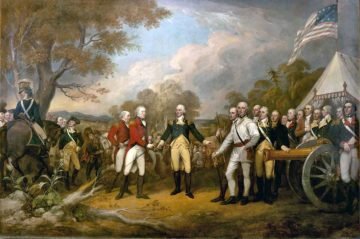
Surrender of General Burgoyne at Battle of Saratoga
On October 8, during the night, Burgoyne ordered a retreat and began to move northward. They eventually made their way back to the fortified British camp at Saratoga, above the Hudson River. The darkness had saved Burgoyne from a complete defeat.
On October 17, Burgoyne was forced to formally surrender to Gates accepted Burgoyne’s surrender of the British army. The formalized surrender was known as the Saratoga Articles of Convention. Gates agreed if the British laid down their arms and returned to England, they would be able to keep their colors and go home as free men.
Burgoyne was allowed to march out of camp “with the Honors of War“, and began their march west. However, when they reached New England, Gates’ terms were not honored by the Continental Congress. Instead, the British soldiers were sent to prison camps.
Aftermath
Burgoyne’s failed campaign, as may be seen by the titles of some of the books that cover it in detail, marked a major turning point in the war. After the battle, he withdrew his men 10–15 miles north, near present-day Schuylerville, New York. Burgoyne returned to England and was never given another commanding position in the British Army.
Burgoyne had lost several of his most effective leaders, his attempts to capture the American position had failed, and his forward line was now breached. That night he lit fires at his remaining forward positions and withdrew under the cover of darkness.
In recognition of his contribution to the battles at Saratoga, Arnold had his seniority restored. His leg wound left Arnold bedridden for five months. Later, while still unfit for field service but serving as military governor of Philadelphia, Arnold entered into treasonous correspondence with the British.
He received command of the fort at West Point and plotted to hand it over to the British, only to flee into the British lines when the capture of his contact Major John Andre led to the exposure of the plot. Arnold went on to serve under Brigadier General William Phillips, the commander of Burgoyne’s right wing, in a 1781 expedition into Virginia.
Although he left the direction of the battle to subordinates, Gates received a great deal of credit as the commanding general for the greatest American victory of the war to date. He may have conspired with others to replace General George Washington as the commander-in-chief. Instead, he received the command of the main American army in the South.
Gates led the army to a disastrous defeat at the 1780 Battle of Camden, where he was at the forefront of a panicked retreat. Gates never commanded troops in the field again. In response to Burgoyne’s surrender, Congress declared December 18, 1777, as a national day “for solemn Thanksgiving and praise“.
Once news of Burgoyne’s surrender reached France, King Louis XVI decided to enter into negotiations with the Americans that resulted in a formal Franco-American alliance and French entry into the war. This moved the conflict onto a global stage. As a consequence, Britain was forced to divert resources used to fight the war in North America to theaters in the West Indies and Europe, and rely on what turned out to be the chimera of Loyalist support in its North American operations.
Being defeated by the British in the French and Indian War more than a decade earlier, France found an opportunity of revenge by aiding the colonists throughout the Revolutionary War. Prior to the Battle of Saratoga, France didn’t fully aid the colonists.
However, after the Battles of Saratoga were conclusively won by the colonists, France realized that the Americans had the hope of winning the war, and began fully aiding the colonists by sending soldiers, donations, loans, military arms, and supplies.
The effect of the American victory at Saratoga was enormous. Gates became known as the “Hero of Saratoga.” The victory also gave the fledgling country some much needed momentum. With both France and Spain joining war, the American effort was galvanized.
The British loss also further weakened the current British government under Lord North. The victory at Bemis Heights and subsequent surrender at Saratoga is generally looked upon as a major turning point in the Revolutionary War.


